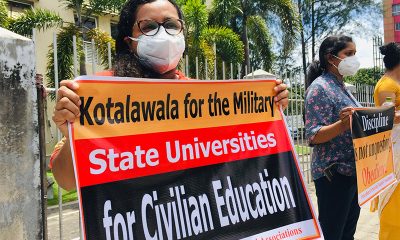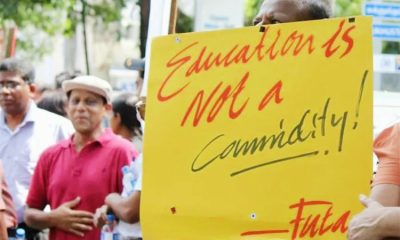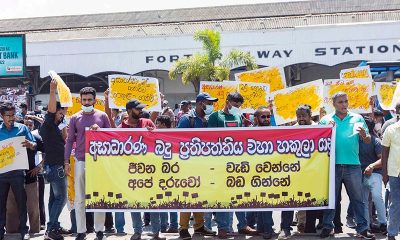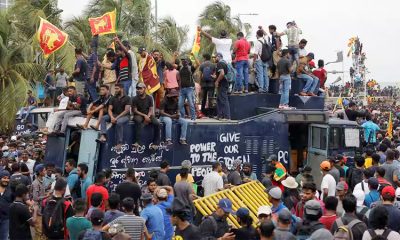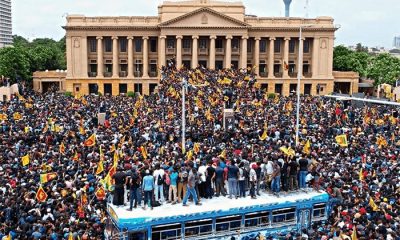Features
Calling applications for MBBS!
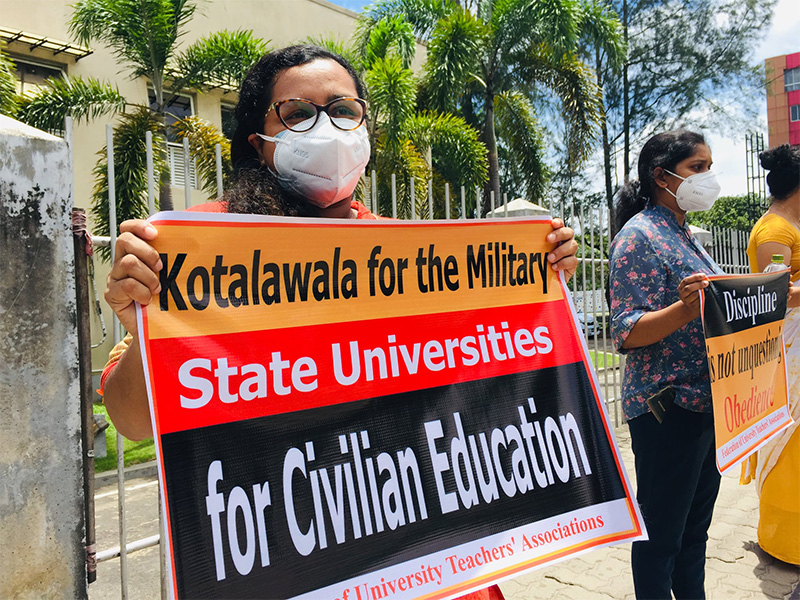
Introducing fees for medical education under military protection
By Ramya Kumar
 Earlier this month the Cabinet approved a proposal presented by the President (as Minister of Defence) to admit fee-levying local students to the medical faculty of the Kotelawala Defence University (KDU). Thereafter, the KDU posted a call for applications from local students (‘day scholars’) to its MBBS programme with a May 5th, 2024, deadline—barely two weeks after the call appeared on the KDU website.
Earlier this month the Cabinet approved a proposal presented by the President (as Minister of Defence) to admit fee-levying local students to the medical faculty of the Kotelawala Defence University (KDU). Thereafter, the KDU posted a call for applications from local students (‘day scholars’) to its MBBS programme with a May 5th, 2024, deadline—barely two weeks after the call appeared on the KDU website.
Medical education is delivered by 13 state medical faculties, 12 under the purview of the University Grants Commission (UGC), plus KDU. Students who obtain the required Z scores at the local A/Ls are eligible for admission to the UGC medical schools on a non-fee levying basis, with a limited number of seats (up to 5%) open to international students who pay USD 62,500 (USD 12,500×5) for their MBBS. KDU’s medical faculty, functioning under the Ministry of Defence, admits military cadres, along with a growing number of fee-paying international students and non-resident Sri Lankans. In other words, none of the existing state medical faculties, including KDU, have enrolled fee-paying local students to this day.
Expansion of private/fee-levying medical education has been resisted by student movements and others concerned about quality of/equity in medical education. In 2021, the government tried to stealthily introduce fee-levying medical education through the Kotelawala National Defence University Bill, which, if enacted, would have permitted the enrolment of local medical students to KDU on a fee-levying basis. Now, with apparently no regard for the law or due process, the Cabinet has approved the President’s proposal, which, if implemented, will drastically alter the landscape of medical education in the country.
Admission criteria
The KDU website lists the admission criteria for its MBBS programme for local day scholars. They should be “unmarried” Sri Lankan citizens in the age group 17-24 years who have completed the G.C.E. (A/L) examination in the year 2022 (or local/foreign equivalent in 2023) and followed the Bio-Science stream (Biology, Chemistry and Physics) and obtained a minimum of two Credit Passes (C) and one Simple Pass (S) (or equivalent at the Cambridge/Edexcel examination) in one sitting, as specified in the Minimum Standards of Medical Education.
These admission criteria expand the pool of eligible candidates by a sizeable proportion since all students with two Cs and an S in bio-sciences may apply. However, the KDU provides very little information about the process they will follow to select candidates (how many?) from this very large pool, except to say that it will involve shortlisting applicants based on their Z score /grades and a “structured selection interview” where the Board of Management will hold “exclusive rights” in selection.
Who will have access
The five-year course will levy LKR 2.5 million per year for five years, amounting to LKR 12.5 million, the equivalent of about USD 42,000. The call for applications does not refer to scholarships or grants for those who may not be able to afford the fees—aspects emphasized in the government’s proposals to expand private higher education detailed in the controversial National Education Policy Framework (NEPF). Apart from the privileged students whose parents can easily afford the fees, others will also be able to sell their assets and take on debt to pay for a MBBS degree. Yet, the application process will be biased in favour of students from elite backgrounds who are better trained to navigate interviews and speak in English.
Indeed, medicine has become an elite profession in many countries due to interview processes that rank applicants based on “soft-skills” and involvement in extra-curricular activities, community service, and other achievements—opportunities that are usually available to a certain class of people. Meanwhile, in Sri Lanka, a phone call to the KDU’s Board of Management from ‘someone who knows someone’ may increase the chances of some candidates securing seats over others. It is widely known that the North Colombo Medical College (NCMC) and SAITM became lodestones for the offspring of doctors.
Questionable justification
With several private medical schools undergoing the Sri Lanka Medical Council’s (SLMC) vetting process, privatizing medical education is justified by politicians, medical professionals and other interlocutors, as a solution to the mass exodus of doctors to greener pastures. Whether the expansion of opportunities for fee-levying/private medical education will actually address the medical brain drain is questionable. For one, it is unrealistic to anticipate that fee-paying medical graduates will remain in the country when lucrative career opportunities are abundant in the West. Even if they do remain here, with hefty fees and the debt incurred to pay them, it is unlikely that they would opt to serve in the public system in remote areas like Padaviya or Puthukkudiyiruppu, where private practice will be limited.
Two strategies are currently used to retain medical professionals in rural areas: the district quotas and mandatory post-internship appointments. First, the district quota system, an affirmative action policy implemented by the UGC, tries to compensate for the deep-seated urban-rural disparities that choke the general education system, and also supports rural retention because medical graduates recruited from these areas are more likely to serve in their home districts/provinces. Second, the Ministry of Health requires all the newly registered doctors it employs to complete a post-internship appointment at an allotted institution, ensuring a widely dispersed medical workforce. Such mandatory service requirements can be implemented at this time because the public system is still the primary employer of medical professionals in the country. Privatising medical education alongside state-incentivised expansion of the commercial hospital sector can facilitate brain drain from public to private, creating a dearth of physicians for the public sector, especially in rural areas, as has happened in India, Thailand, and Malaysia.
There is also the argument that permitting local students access to fee-levying medical education will save the country foreign exchange. Although expanding opportunities at state medical faculties may do this to a certain extent, the government aspires to attract foreign investors into the higher education sector. As stated in the NEPF, “Limits to ownership by foreign investors in Higher Education and Skills Development shall be removed with an investment threshold to attract high quality institutions.” In reality, international universities are driven by profit to be incurred locally and channelled overseas.
‘Strategic planning’
The government has craftily planned its strategy to expand private medical education post-Aragalaya. While state funding for state universities has been slashed to new lows, university administrations have been directed to self-generate funds through fee-levying degree programmes. The slightest form of protest by the student movement has been quickly stifled with many medical students and others arrested or facing intimidation from the military and law enforcement authorities. The state’s propaganda machine has painted a picture of perpetually protesting students and self-interested university teachers. Middle-class sentiments regarding state universities are at an all-time low with the Colombo elite vocally denigrating state universities and their graduates, while promoting private higher education.
Although there is wide consensus that the advent of private medical schools should not affect the delivery of state MBBS programmes, there are no mechanisms in place to ensure this. The SLMC’s accreditation standards consider state medical schools and others on par with each other, and the government has failed to take effective measures to strengthen medical faculties located in peripheral districts. Even today, certain medical faculties struggle to gain SLMC accreditation owing to a dearth of staff in their professorial units. There is no doubt that the more lucrative fee-levying medical schools will prey on the scarce resources of state medical faculties, making this situation worse.
Why is our generation who has benefitted from the Free Education policy so ready to give it up for future generations? Privatisation is not a solution to the many problems of and faced by the university system. Reforms are needed, but we need to arrive at these through a process of consultation. Rather than pushing through hasty, short-sighted educational reforms that appear to be driven by economic imperatives and narrow class interests, why not work on strengthening what we presently have?
It is no coincidence that KDU—an institution that can easily deploy the military—has been selected as the first experiment. Any resistance will be easily quelled unless there is a groundswell of public protest against these developments and other attempts to subvert Free Education in this country. While these decisions are being made by a President and Cabinet who have long lost whatever mandate they had, it is crucial that those aspiring to take over unambiguously express their views on this as a matter of urgency.
(Ramya Kumar is attached to the Department of Community and Family Medicine, University of Jaffna)
Kuppi is a politics and a pedagogy happening on the margins of the lecture hall that parodies, subverts and simultaneously reaffirms social hierarchies.
Features
The heart-friendly health minister

by Dr Gotabhya Ranasinghe
Senior Consultant Cardiologist
National Hospital Sri Lanka
When we sought a meeting with Hon Dr. Ramesh Pathirana, Minister of Health, he graciously cleared his busy schedule to accommodate us. Renowned for his attentive listening and deep understanding, Minister Pathirana is dedicated to advancing the health sector. His openness and transparency exemplify the qualities of an exemplary politician and minister.
Dr. Palitha Mahipala, the current Health Secretary, demonstrates both commendable enthusiasm and unwavering support. This combination of attributes makes him a highly compatible colleague for the esteemed Minister of Health.
Our discussion centered on a project that has been in the works for the past 30 years, one that no other minister had managed to advance.
Minister Pathirana, however, recognized the project’s significance and its potential to revolutionize care for heart patients.
The project involves the construction of a state-of-the-art facility at the premises of the National Hospital Colombo. The project’s location within the premises of the National Hospital underscores its importance and relevance to the healthcare infrastructure of the nation.
This facility will include a cardiology building and a tertiary care center, equipped with the latest technology to handle and treat all types of heart-related conditions and surgeries.
Securing funding was a major milestone for this initiative. Minister Pathirana successfully obtained approval for a $40 billion loan from the Asian Development Bank. With the funding in place, the foundation stone is scheduled to be laid in September this year, and construction will begin in January 2025.
This project guarantees a consistent and uninterrupted supply of stents and related medications for heart patients. As a result, patients will have timely access to essential medical supplies during their treatment and recovery. By securing these critical resources, the project aims to enhance patient outcomes, minimize treatment delays, and maintain the highest standards of cardiac care.
Upon its fruition, this monumental building will serve as a beacon of hope and healing, symbolizing the unwavering dedication to improving patient outcomes and fostering a healthier society.We anticipate a future marked by significant progress and positive outcomes in Sri Lanka’s cardiovascular treatment landscape within the foreseeable timeframe.
Features
A LOVING TRIBUTE TO JESUIT FR. ALOYSIUS PIERIS ON HIS 90th BIRTHDAY

by Fr. Emmanuel Fernando, OMI
Jesuit Fr. Aloysius Pieris (affectionately called Fr. Aloy) celebrated his 90th birthday on April 9, 2024 and I, as the editor of our Oblate Journal, THE MISSIONARY OBLATE had gone to press by that time. Immediately I decided to publish an article, appreciating the untiring selfless services he continues to offer for inter-Faith dialogue, the renewal of the Catholic Church, his concern for the poor and the suffering Sri Lankan masses and to me, the present writer.
It was in 1988, when I was appointed Director of the Oblate Scholastics at Ampitiya by the then Oblate Provincial Fr. Anselm Silva, that I came to know Fr. Aloy more closely. Knowing well his expertise in matters spiritual, theological, Indological and pastoral, and with the collaborative spirit of my companion-formators, our Oblate Scholastics were sent to Tulana, the Research and Encounter Centre, Kelaniya, of which he is the Founder-Director, for ‘exposure-programmes’ on matters spiritual, biblical, theological and pastoral. Some of these dimensions according to my view and that of my companion-formators, were not available at the National Seminary, Ampitiya.
Ever since that time, our Oblate formators/ accompaniers at the Oblate Scholasticate, Ampitiya , have continued to send our Oblate Scholastics to Tulana Centre for deepening their insights and convictions regarding matters needed to serve the people in today’s context. Fr. Aloy also had tried very enthusiastically with the Oblate team headed by Frs. Oswald Firth and Clement Waidyasekara to begin a Theologate, directed by the Religious Congregations in Sri Lanka, for the contextual formation/ accompaniment of their members. It should very well be a desired goal of the Leaders / Provincials of the Religious Congregations.
Besides being a formator/accompanier at the Oblate Scholasticate, I was entrusted also with the task of editing and publishing our Oblate journal, ‘The Missionary Oblate’. To maintain the quality of the journal I continue to depend on Fr. Aloy for his thought-provoking and stimulating articles on Biblical Spirituality, Biblical Theology and Ecclesiology. I am very grateful to him for his generous assistance. Of late, his writings on renewal of the Church, initiated by Pope St. John XX111 and continued by Pope Francis through the Synodal path, published in our Oblate journal, enable our readers to focus their attention also on the needed renewal in the Catholic Church in Sri Lanka. Fr. Aloy appreciated very much the Synodal path adopted by the Jesuit Pope Francis for the renewal of the Church, rooted very much on prayerful discernment. In my Religious and presbyteral life, Fr.Aloy continues to be my spiritual animator / guide and ongoing formator / acccompanier.
Fr. Aloysius Pieris, BA Hons (Lond), LPh (SHC, India), STL (PFT, Naples), PhD (SLU/VC), ThD (Tilburg), D.Ltt (KU), has been one of the eminent Asian theologians well recognized internationally and one who has lectured and held visiting chairs in many universities both in the West and in the East. Many members of Religious Congregations from Asian countries have benefited from his lectures and guidance in the East Asian Pastoral Institute (EAPI) in Manila, Philippines. He had been a Theologian consulted by the Federation of Asian Bishops’ Conferences for many years. During his professorship at the Gregorian University in Rome, he was called to be a member of a special group of advisers on other religions consulted by Pope Paul VI.
Fr. Aloy is the author of more than 30 books and well over 500 Research Papers. Some of his books and articles have been translated and published in several countries. Among those books, one can find the following: 1) The Genesis of an Asian Theology of Liberation (An Autobiographical Excursus on the Art of Theologising in Asia, 2) An Asian Theology of Liberation, 3) Providential Timeliness of Vatican 11 (a long-overdue halt to a scandalous millennium, 4) Give Vatican 11 a chance, 5) Leadership in the Church, 6) Relishing our faith in working for justice (Themes for study and discussion), 7) A Message meant mainly, not exclusively for Jesuits (Background information necessary for helping Francis renew the Church), 8) Lent in Lanka (Reflections and Resolutions, 9) Love meets wisdom (A Christian Experience of Buddhism, 10) Fire and Water 11) God’s Reign for God’s poor, 12) Our Unhiddden Agenda (How we Jesuits work, pray and form our men). He is also the Editor of two journals, Vagdevi, Journal of Religious Reflection and Dialogue, New Series.
Fr. Aloy has a BA in Pali and Sanskrit from the University of London and a Ph.D in Buddhist Philosophy from the University of Sri Lankan, Vidyodaya Campus. On Nov. 23, 2019, he was awarded the prestigious honorary Doctorate of Literature (D.Litt) by the Chancellor of the University of Kelaniya, the Most Venerable Welamitiyawe Dharmakirthi Sri Kusala Dhamma Thera.
Fr. Aloy continues to be a promoter of Gospel values and virtues. Justice as a constitutive dimension of love and social concern for the downtrodden masses are very much noted in his life and work. He had very much appreciated the commitment of the late Fr. Joseph (Joe) Fernando, the National Director of the Social and Economic Centre (SEDEC) for the poor.
In Sri Lanka, a few religious Congregations – the Good Shepherd Sisters, the Christian Brothers, the Marist Brothers and the Oblates – have invited him to animate their members especially during their Provincial Congresses, Chapters and International Conferences. The mainline Christian Churches also have sought his advice and followed his seminars. I, for one, regret very much, that the Sri Lankan authorities of the Catholic Church –today’s Hierarchy—- have not sought Fr.
Aloy’s expertise for the renewal of the Catholic Church in Sri Lanka and thus have not benefited from the immense store of wisdom and insight that he can offer to our local Church while the Sri Lankan bishops who governed the Catholic church in the immediate aftermath of the Second Vatican Council (Edmund Fernando OMI, Anthony de Saram, Leo Nanayakkara OSB, Frank Marcus Fernando, Paul Perera,) visited him and consulted him on many matters. Among the Tamil Bishops, Bishop Rayappu Joseph was keeping close contact with him and Bishop J. Deogupillai hosted him and his team visiting him after the horrible Black July massacre of Tamils.
Features
A fairy tale, success or debacle

Sri Lanka-Singapore Free Trade Agreement
By Gomi Senadhira
senadhiragomi@gmail.com
“You might tell fairy tales, but the progress of a country cannot be achieved through such narratives. A country cannot be developed by making false promises. The country moved backward because of the electoral promises made by political parties throughout time. We have witnessed that the ultimate result of this is the country becoming bankrupt. Unfortunately, many segments of the population have not come to realize this yet.” – President Ranil Wickremesinghe, 2024 Budget speech
Any Sri Lankan would agree with the above words of President Wickremesinghe on the false promises our politicians and officials make and the fairy tales they narrate which bankrupted this country. So, to understand this, let’s look at one such fairy tale with lots of false promises; Ranil Wickremesinghe’s greatest achievement in the area of international trade and investment promotion during the Yahapalana period, Sri Lanka-Singapore Free Trade Agreement (SLSFTA).
It is appropriate and timely to do it now as Finance Minister Wickremesinghe has just presented to parliament a bill on the National Policy on Economic Transformation which includes the establishment of an Office for International Trade and the Sri Lanka Institute of Economics and International Trade.
Was SLSFTA a “Cleverly negotiated Free Trade Agreement” as stated by the (former) Minister of Development Strategies and International Trade Malik Samarawickrama during the Parliamentary Debate on the SLSFTA in July 2018, or a colossal blunder covered up with lies, false promises, and fairy tales? After SLSFTA was signed there were a number of fairy tales published on this agreement by the Ministry of Development Strategies and International, Institute of Policy Studies, and others.
However, for this article, I would like to limit my comments to the speech by Minister Samarawickrama during the Parliamentary Debate, and the two most important areas in the agreement which were covered up with lies, fairy tales, and false promises, namely: revenue loss for Sri Lanka and Investment from Singapore. On the other important area, “Waste products dumping” I do not want to comment here as I have written extensively on the issue.
1. The revenue loss
During the Parliamentary Debate in July 2018, Minister Samarawickrama stated “…. let me reiterate that this FTA with Singapore has been very cleverly negotiated by us…. The liberalisation programme under this FTA has been carefully designed to have the least impact on domestic industry and revenue collection. We have included all revenue sensitive items in the negative list of items which will not be subject to removal of tariff. Therefore, 97.8% revenue from Customs duty is protected. Our tariff liberalisation will take place over a period of 12-15 years! In fact, the revenue earned through tariffs on goods imported from Singapore last year was Rs. 35 billion.
The revenue loss for over the next 15 years due to the FTA is only Rs. 733 million– which when annualised, on average, is just Rs. 51 million. That is just 0.14% per year! So anyone who claims the Singapore FTA causes revenue loss to the Government cannot do basic arithmetic! Mr. Speaker, in conclusion, I call on my fellow members of this House – don’t mislead the public with baseless criticism that is not grounded in facts. Don’t look at petty politics and use these issues for your own political survival.”
I was surprised to read the minister’s speech because an article published in January 2018 in “The Straits Times“, based on information released by the Singaporean Negotiators stated, “…. With the FTA, tariff savings for Singapore exports are estimated to hit $10 million annually“.
As the annual tariff savings (that is the revenue loss for Sri Lanka) calculated by the Singaporean Negotiators, Singaporean $ 10 million (Sri Lankan rupees 1,200 million in 2018) was way above the rupees’ 733 million revenue loss for 15 years estimated by the Sri Lankan negotiators, it was clear to any observer that one of the parties to the agreement had not done the basic arithmetic!
Six years later, according to a report published by “The Morning” newspaper, speaking at the Committee on Public Finance (COPF) on 7th May 2024, Mr Samarawickrama’s chief trade negotiator K.J. Weerasinghehad had admitted “…. that forecasted revenue loss for the Government of Sri Lanka through the Singapore FTA is Rs. 450 million in 2023 and Rs. 1.3 billion in 2024.”
If these numbers are correct, as tariff liberalisation under the SLSFTA has just started, we will pass Rs 2 billion very soon. Then, the question is how Sri Lanka’s trade negotiators made such a colossal blunder. Didn’t they do their basic arithmetic? If they didn’t know how to do basic arithmetic they should have at least done their basic readings. For example, the headline of the article published in The Straits Times in January 2018 was “Singapore, Sri Lanka sign FTA, annual savings of $10m expected”.
Anyway, as Sri Lanka’s chief negotiator reiterated at the COPF meeting that “…. since 99% of the tariffs in Singapore have zero rates of duty, Sri Lanka has agreed on 80% tariff liberalisation over a period of 15 years while expecting Singapore investments to address the imbalance in trade,” let’s turn towards investment.
Investment from Singapore
In July 2018, speaking during the Parliamentary Debate on the FTA this is what Minister Malik Samarawickrama stated on investment from Singapore, “Already, thanks to this FTA, in just the past two-and-a-half months since the agreement came into effect we have received a proposal from Singapore for investment amounting to $ 14.8 billion in an oil refinery for export of petroleum products. In addition, we have proposals for a steel manufacturing plant for exports ($ 1 billion investment), flour milling plant ($ 50 million), sugar refinery ($ 200 million). This adds up to more than $ 16.05 billion in the pipeline on these projects alone.
And all of these projects will create thousands of more jobs for our people. In principle approval has already been granted by the BOI and the investors are awaiting the release of land the environmental approvals to commence the project.
I request the Opposition and those with vested interests to change their narrow-minded thinking and join us to develop our country. We must always look at what is best for the whole community, not just the few who may oppose. We owe it to our people to courageously take decisions that will change their lives for the better.”
According to the media report I quoted earlier, speaking at the Committee on Public Finance (COPF) Chief Negotiator Weerasinghe has admitted that Sri Lanka was not happy with overall Singapore investments that have come in the past few years in return for the trade liberalisation under the Singapore-Sri Lanka Free Trade Agreement. He has added that between 2021 and 2023 the total investment from Singapore had been around $162 million!
What happened to those projects worth $16 billion negotiated, thanks to the SLSFTA, in just the two-and-a-half months after the agreement came into effect and approved by the BOI? I do not know about the steel manufacturing plant for exports ($ 1 billion investment), flour milling plant ($ 50 million) and sugar refinery ($ 200 million).
However, story of the multibillion-dollar investment in the Petroleum Refinery unfolded in a manner that would qualify it as the best fairy tale with false promises presented by our politicians and the officials, prior to 2019 elections.
Though many Sri Lankans got to know, through the media which repeatedly highlighted a plethora of issues surrounding the project and the questionable credentials of the Singaporean investor, the construction work on the Mirrijiwela Oil Refinery along with the cement factory began on the24th of March 2019 with a bang and Minister Ranil Wickremesinghe and his ministers along with the foreign and local dignitaries laid the foundation stones.
That was few months before the 2019 Presidential elections. Inaugurating the construction work Prime Minister Ranil Wickremesinghe said the projects will create thousands of job opportunities in the area and surrounding districts.
The oil refinery, which was to be built over 200 acres of land, with the capacity to refine 200,000 barrels of crude oil per day, was to generate US$7 billion of exports and create 1,500 direct and 3,000 indirect jobs. The construction of the refinery was to be completed in 44 months. Four years later, in August 2023 the Cabinet of Ministers approved the proposal presented by President Ranil Wickremesinghe to cancel the agreement with the investors of the refinery as the project has not been implemented! Can they explain to the country how much money was wasted to produce that fairy tale?
It is obvious that the President, ministers, and officials had made huge blunders and had deliberately misled the public and the parliament on the revenue loss and potential investment from SLSFTA with fairy tales and false promises.
As the president himself said, a country cannot be developed by making false promises or with fairy tales and these false promises and fairy tales had bankrupted the country. “Unfortunately, many segments of the population have not come to realize this yet”.
(The writer, a specialist and an activist on trade and development issues . )


